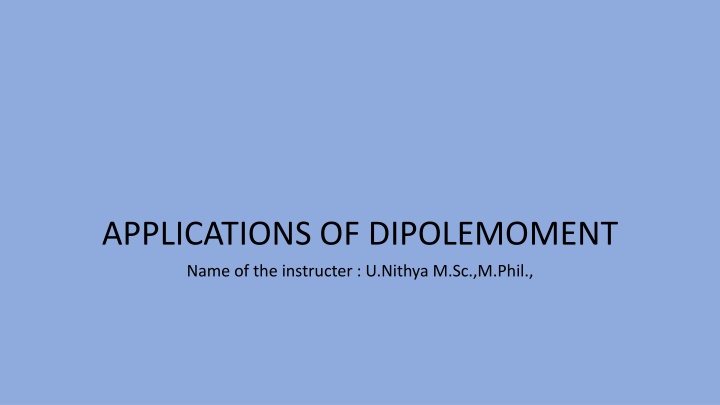
Applications of Dipole Moment in Molecules and Isomers
Explore the applications and significance of dipole moment in different molecules and isomers. Learn about the distinction between cis and trans isomers, bond angles, and the presence of resonance in molecules. Get insights from the dipole moment values analyzed in various compounds.
Download Presentation

Please find below an Image/Link to download the presentation.
The content on the website is provided AS IS for your information and personal use only. It may not be sold, licensed, or shared on other websites without obtaining consent from the author. If you encounter any issues during the download, it is possible that the publisher has removed the file from their server.
You are allowed to download the files provided on this website for personal or commercial use, subject to the condition that they are used lawfully. All files are the property of their respective owners.
The content on the website is provided AS IS for your information and personal use only. It may not be sold, licensed, or shared on other websites without obtaining consent from the author.
E N D
Presentation Transcript
APPLICATIONS OF DIPOLEMOMENT Name of the instructer : U.Nithya M.Sc.,M.Phil.,
Shape of molecules: * Dipolemoment of CO2 is zero. Also HCN, RCl,R-OH,RCN are zero dipolemoment. Because central atoms are symmetrical. * Dipolemoment of H2O = 1.85 D * H2,N2,I2etc., do not have dipolemoments since the bonds in them are non-polar. * p- dicholoro benzene is zero dipolemoment. Because the two chlorine atoms are symmetrical, but P-dimethoxy,P-dihydroxy functional groups benzenes are not equal to zero. Because the arrangement in not symmetrical.
Distinction between cis and trans isomers: The dipolemoment of the two groups in the trans positions will cancel each other. So the trans form will have Zero dipolemoment. The cis from will have considerable dipolemoment. Dipole moments of linkages: The dipolemoments of a number of compounds have been analysed. H-C. C-O. C-Cl. H-O. C=O 0.4. 0.7. 1.5. 1.6. 2.3D
Presence of resonance: From the dipole moment values we can establish the presence of resonance or mesomerism in molecules. Eg. Ortho para directing groups like halogens have smaller moments when substotuted in a benzene ring than when attached to a saturated aliphatic group. This is due to resonance present in the molecule.






















